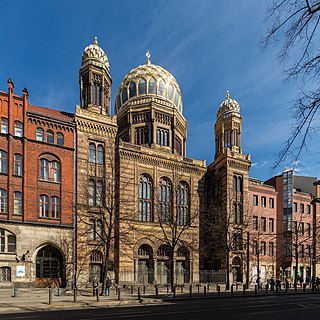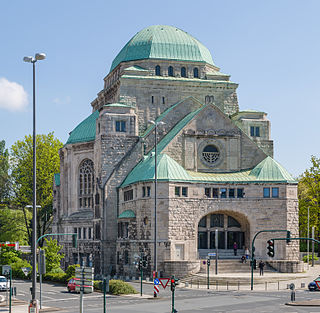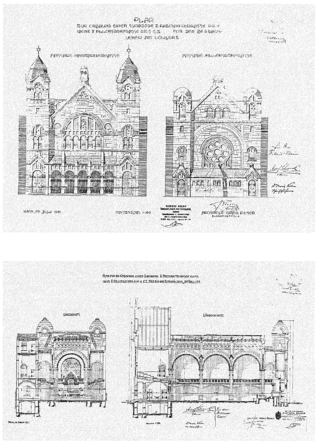
The New Synagogue on Oranienburger Straße in Berlin is a mid-19th century synagogue built as the main place of worship for the city's Jewish community, succeeding the Old Synagogue which the community outgrew. Because of its eastern Moorish style and resemblance to the Alhambra, the New Synagogue is an important architectural monument in Germany.

The Old Synagogue is a former [Reform Judaism|Reform]] Jewish congregation and synagogue, located at Steeler Straße 29, in Essen, in the state of North Rhine-Westphalia, Germany. The former synagogue was repurposed in 1960 as a Jewish museum.

The Fasanenstrasse Synagogue was a former liberal Jewish congregation and synagogue, that was located at 79–80 Fasanenstrasse off Kurfürstendamm, in the affluent neighbourhood of Charlottenburg, in Berlin, Germany. Completed on 26 August 1912, the synagogue was located close to the Berlin Stadtbahn and Zoo Station.

The Pazmanitentempel, also known as the Jubiläumstempel, was a Jewish synagogue, located at Pazmanitengasse 6, Leopoldstadt, in the 2nd district of Vienna, Austria. Completed in 1913, the synagogue was destroyed on Kristallnacht in 1938.

Ichenhausen is a town in the district of Günzburg, in Bavaria, Germany. It is situated on the river Günz, 9 km south of Günzburg.

The New Synagogue was a former Reform Jewish congregation and synagogue, located in Breslau, Germany. It was one of the largest synagogues in the German Empire and a centre of Reform Judaism in Breslau. Designed by Edwin Oppler in the Romanesque Revival style and completed in 1872, the synagogue was destroyed during the Kristallnacht pogrom which swept across Nazi Germany on 9–10 November 1938.

The New Synagogue was a former Reform Jewish congregation and synagogue, located in Oppeln, Germany. The synagogue was destroyed by Nazis on November 9, 1938, during Kristallnacht.

The New Synagogue was a former Reform Jewish congregation and synagogue, located in Gleiwitz, Germany.

Hainsfarth is a municipality in the district of Donau-Ries in Bavaria in Germany.

The Semper Synagogue, also known as the Dresden Synagogue or Old Synagogue, was a Jewish synagogue, located in Dresden, in the Saxony region of Germany. Designed by Gottfried Semper and built from 1838 to 1840 in the Romanesque Revival and Moorish Revival styles, the synagogue was destroyed by the Nazis on November 9, 1938, during Kristallnacht.

The Worms Synagogue, also known as Rashi Shul, is a Jewish congregation and synagogue located in the northern part of the city center of Worms, in the Rhineland-Palatinate region of Germany.

Gau Swabia, formed on 1 October 1928, was an administrative division of Nazi Germany in Swabia, Bavaria, from 1933 to 1945. From 1928 to 1933, it was the regional subdivision of the Nazi Party in that area.

The Krnov Synagogue is a former Jewish synagogue, located on Soukenická Street in Krnov, in the Czech Republic. Completed in 1871, the former synagogue is one of only three surviving synagogue buildings in the Moravian-Silesian Region.

The Kassel Synagogue was a former Jewish congregation and synagogue, located on Untere Königsstraße, in Kassel, Hesse, Germany. The second synagogue for the congregation, it was completed in 1839 and destroyed by Nazis on November 9, 1938, during Kristallnacht.

The Karlsruhe Synagogue was a Jewish congregation and synagogue, located in Karlsruhe, in the state of Baden-Württemberg, Germany. Designed by Friedrich Weinbrenner in the Egyptian Revival style, the synagogue was completed in 1798 and demolished in 1871.

The Old Synagogue was a former Jewish congregation and synagogue, located in Dortmund, in the state of North Rhine-Westphalia, Germany. Completed in 1900, the synagogue was abandoned in 1933 and demolished in 1938. Prior to its abandonment, the synagogue was the largest synagogue and cultural center of the Jewish community in Dortmund.

The Rottweil Synagogue was a former Jewish congregation and synagogue, located in Rottweil, in the state of Baden-Württemberg, Germany. Completed in 1861, the synagogue was destroyed by Nazis during Kristallnacht, on November 9, 1938. The desecrated synagogue is located in Kameralamtsgasse 6, former Judengasse, close to Kapellenkirche and next to Bischöfliches Konvikt and gymnasium. The building was used as the Hartmut Benk driving school up until 2019.

The Kłodzko Synagogue, officially the Synagogue of Kłodzko, and formerly the Synagogue in Glatz, was a former Reform Jewish congregation and synagogue, located on the Grünestraße, in Glatz, Germany. This location is now Wojska Polskiego Street, in Kłodzko, in Kłodzko County in Lower Silesia, Poland.

The Fraenkelufer Synagogue is a Conservative congregation and synagogue located on Kottbusser Ufer 48–50, today's Fraenkelufer 10-16, in the Kreuzberg district of Berlin, Germany.

The Görlitz Synagogue is a Jewish congregation and synagogue, located on Otto-Müller-Straße, in Görlitz, Germany. Built between 1909 and 1911 in the Art Nouveau style, the synagogue was the main place of worship for the city's Ashkenazi Jewish community. Despite an arson attack, the synagogue was one of the few synagogues in the area to survive Kristallnacht, sustaining only minor damage. The damage was lessened as firefighters ignored the Nazi German orders to let the synagogue burn. With the city's Jewish population depleted, the unused synagogue became a ruin in the following decades.





















